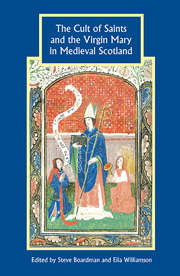Book contents
- Frontmatter
- Contents
- List of Illustrations and Tables
- List of Contributors
- Abbreviations
- Introduction
- 1 The Big Man, the Footsteps, and the Fissile Saint: paradigms and problems in studies of insular saints' cults
- 2 St Munnu in Ireland and Scotland: an exploration of his cult
- 3 The struggle for sanctity: St Waltheof of Melrose, Cistercian in-house cults and canonisation procedure at the turn of the thirteenth century
- 4 Royal and aristocratic attitudes to saints and the Virgin Mary in twelfth- and thirteenth-century Scotland
- 5 A saintly sinner? The ‘martyrdom’ of David, duke of Rothesay
- 6 Wo/men only? Marian devotion in medieval Perth
- 7 Is eagal liom lá na hagra: devotion to the Virgin in the later medieval Gàidhealtachd
- 8 Scottish saints' legends in the Aberdeen Breviary
- 9 Mothers and their sons: Mary and Jesus in Scotland, 1450–1560
- 10 The ‘McRoberts thesis’ and patterns of sanctity in late medieval Scotland
- Index
9 - Mothers and their sons: Mary and Jesus in Scotland, 1450–1560
Published online by Cambridge University Press: 05 October 2013
- Frontmatter
- Contents
- List of Illustrations and Tables
- List of Contributors
- Abbreviations
- Introduction
- 1 The Big Man, the Footsteps, and the Fissile Saint: paradigms and problems in studies of insular saints' cults
- 2 St Munnu in Ireland and Scotland: an exploration of his cult
- 3 The struggle for sanctity: St Waltheof of Melrose, Cistercian in-house cults and canonisation procedure at the turn of the thirteenth century
- 4 Royal and aristocratic attitudes to saints and the Virgin Mary in twelfth- and thirteenth-century Scotland
- 5 A saintly sinner? The ‘martyrdom’ of David, duke of Rothesay
- 6 Wo/men only? Marian devotion in medieval Perth
- 7 Is eagal liom lá na hagra: devotion to the Virgin in the later medieval Gàidhealtachd
- 8 Scottish saints' legends in the Aberdeen Breviary
- 9 Mothers and their sons: Mary and Jesus in Scotland, 1450–1560
- 10 The ‘McRoberts thesis’ and patterns of sanctity in late medieval Scotland
- Index
Summary
In the past few decades there has been a great deal of interest expressed in the history of the family in medieval Europe, particularly the emotional bonds between parents and children. Analysing royal families is one place to start exploring familial bonds. Lois Huneycutt has begun the process for Scottish history by studying St Margaret of Scotland (ob. 1093) and her children. Investigating the portrayal of the relationship between the Blessed Virgin Mary and Jesus is another route to understanding affective familial relations. Scots were children of Mary and siblings of Jesus, believing that a fuller understanding of Mary and Jesus's relationship brought them closer to salvation. They were taught that Mary and Jesus shared a close emotional bond forged through a lifetime of interaction. Jesus began life as a nursing infant clinging to His mother's arms, and ended it as a voluntary sacrifice for human sin. His ascension into heaven, and Mary's later assumption, did not break this tie. Mother and son remained close, working to rescue humanity from sin. Lay people were taught about the Trinity, but tended to distinguish between Jesus and God; Mary was believed to have allied herself with the Son rather than the Father. This mother-son alliance gave humanity hope for salvation, for Mary's determination to help people at Judgement was matched by her influence over Jesus. Whether as human son or resurrected king, Jesus appeared willing to forgive sinners at His mother's request.
- Type
- Chapter
- Information
- The Cult of Saints and the Virgin Mary in Medieval Scotland , pp. 159 - 176Publisher: Boydell & BrewerPrint publication year: 2010



